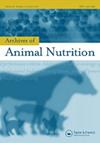Vitamin D in dairy cows: metabolism, status and functions in the immune system
IF 1.5
3区 农林科学
Q1 AGRICULTURE, DAIRY & ANIMAL SCIENCE
引用次数: 10
Abstract
ABSTRACT The function of vitamin D in calcium homoeostasis in dairy cows, such as in other vertebrates, is known for many years. In recent years, new and interesting, non-classical functions of vitamin D have been elucidated, including effects on the immune system. The major aim of this review is to provide an overview of effects of vitamin D or its metabolites on the immune system in dairy cows. The first part of the review provides an overview of vitamin D metabolism, with particular reference to the role of various proteins (25- and 1-hydroxylases, vitamin D binding protein, vitamin D receptor) in vitamin D signalling. The second part deals with the role of the concentration of 25-hydroxyvitamin D [25(OH)D] in plasma as an indicator of the vitamin D status in dairy cows, and its dependence on sunlight exposure and dietary vitamin D supplementation. In this part also the “free hormone hypothesis” is discussed, indicating that the concentration of free 25(OH)D might be a more valid indicator of the vitamin D status than the concentration of total 25(OH)D. The third part deals with classical and the non-classical functions of vitamin D. Among the non-classical functions which are based on an autocrine vitamin D signalling, particular reference is given to the effects of vitamin D and vitamin D metabolites on the immune system in bovine immune cells and in dairy cows. Recent findings provide some indication that vitamin D or its metabolite 25(OH)D could enhance the immune function in dairy cows and be useful for the prevention and therapy of mastitis. However, the number of studies reported so far in this respect is very limited. Thus, much more research is required to yield clear concepts for an optimised usage of vitamin D to improve the immune system and prevent infectious diseases in dairy cows.奶牛体内的维生素D:在免疫系统中的代谢、状态和功能
与其他脊椎动物一样,维生素D在奶牛体内钙平衡中的作用已被发现多年。近年来,新的、有趣的、非经典的维生素D功能已经被阐明,包括对免疫系统的影响。本综述的主要目的是概述维生素D及其代谢产物对奶牛免疫系统的影响。综述的第一部分概述了维生素D代谢,特别提到了各种蛋白质(25-和1-羟化酶,维生素D结合蛋白,维生素D受体)在维生素D信号传导中的作用。第二部分研究了血浆中25-羟基维生素D [25(OH)D]浓度作为奶牛维生素D状态指标的作用,以及其对阳光照射和日粮维生素D补充的依赖。这一部分还讨论了“游离激素假说”,表明游离25(OH)D的浓度可能比总25(OH)D的浓度更有效地指示维生素D的状态。第三部分讨论了维生素D的经典和非经典功能。在基于自分泌维生素D信号的非经典功能中,特别提到了维生素D和维生素D代谢物对牛免疫细胞和奶牛免疫系统的影响。最近的研究结果表明,维生素D或其代谢产物25(OH)D可以增强奶牛的免疫功能,有助于预防和治疗乳腺炎。然而,迄今为止在这方面报道的研究数量非常有限。因此,需要更多的研究来得出明确的概念,以优化维生素D的使用,以改善奶牛的免疫系统和预防传染病。
本文章由计算机程序翻译,如有差异,请以英文原文为准。
求助全文
约1分钟内获得全文
求助全文
来源期刊

Archives of Animal Nutrition
农林科学-奶制品与动物科学
CiteScore
3.90
自引率
5.00%
发文量
31
审稿时长
>24 weeks
期刊介绍:
Archives of Animal Nutrition is an international journal covering the biochemical and physiological basis of animal nutrition. Emphasis is laid on original papers on protein and amino acid metabolism, energy transformation, mineral metabolism, vitamin metabolism, nutritional effects on intestinal and body functions in combination with performance criteria, respectively. It furthermore deals with recent developments in practical animal feeding, feedstuff theory, mode of action of feed additives, feedstuff preservation and feedstuff processing. The spectrum covers all relevant animal species including food producing and companion animals, but not aquatic species.
Seldom can priority be given to papers covering more descriptive studies, even if they may be interesting and technically sound or of impact for animal production, or for topics of relevance for only particular regional conditions.
 求助内容:
求助内容: 应助结果提醒方式:
应助结果提醒方式:


